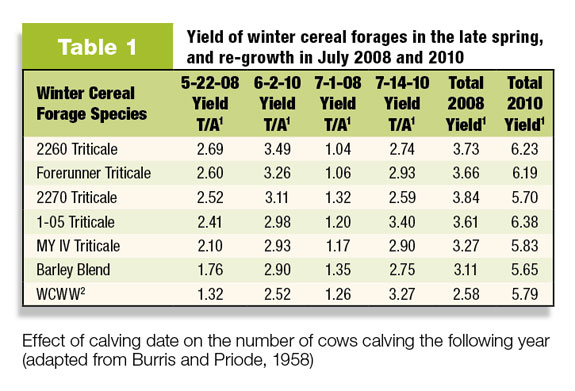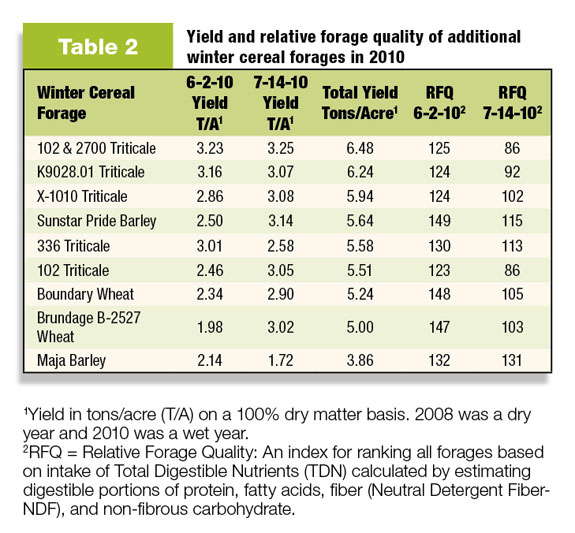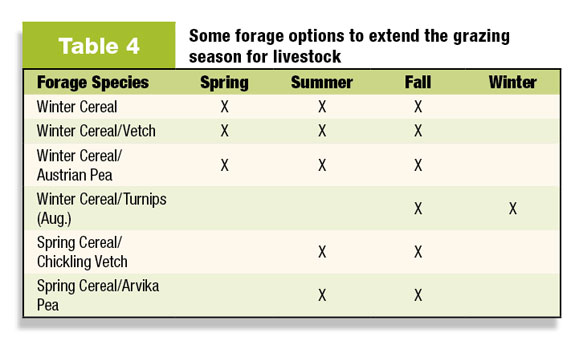
The forage species choice will depend on the desired outcome.
This article focuses on irrigated winter cereal forage yield and quality in southern Idaho, and their potential for extending the livestock grazing season to reduce feed costs in areas with similar growing conditions.
Replicated research trials and on-farm trials were completed to assess forages for extended grazing. The data from the replicated trials is presented with additional management practices included from the on-farm trials.

Cereal forages
Net farm or ranch profit can be improved by raising alfalfa on more productive farm ground, while using more marginal ground to raise your own winter cereal forages for your livestock.
Planting winter cereals for grazing can keep dollars in your pocket by capitalizing on natural precipitation to reduce irrigation costs, and eliminating harvest costs.
Winter cereals yielded 2.6 to 6.5 ton per acre (T per A) on a 100 percent dry matter basis (Tables 1 and 2 above) with irrigation for establishment in the fall and three to five irrigations in the spring/early summer.
The available crude protein (CP) levels were 11.9 to 17.8 percent in the spring for the winter cereals (Table 2).
The relative forage quality (RFQ) values for winter cereals in the spring ranged from 123 to 173 (Table 3), which is comparable to alfalfa with fair to good quality.
Click here or on the image above to view it at full size in a new window.
Winter cereals can be grazed during the spring, summer or fall to reduce dependence on hay. In the spring, winter cereals provide a larger biomass of high-quality forage earlier than pastures.
Grazing the winter cereals first allows the pastures more time to produce larger amounts of forage before turning livestock onto them.
Grazing during the summer on cereal forage re-growth can provide much-needed forage when perennial pasture growth slows during hot weather. One to 3.4 T per A of forage can be obtained just from the re-growth (Tables 1 and 2).
In July, the forage quality of winter cereal re-growth drops to a level similar to utility alfalfa (Table 3), but the only cost of this re-growth is a couple of irrigations.
Winter cereals planted in August can be grazed in the fall and again in the spring. Winter cereals can also be mixed with turnips or legumes like Austrian winter peas, hairy vetch or chickling vetch to increase the forage quality for fall/winter grazing.
If winter cereals don’t fit your operation, then substitute spring cereal crops like oats, beardless barley or awnless wheat for extended summer and fall grazing.

Summary
Winter cereals provide high-quality, good-yielding forages in the spring and fair-quality, low-cost re-growth in July for extending the grazing season.
Combining winter cereal forages with other crops can increase the forage quality and extend the fall/winter grazing (Table 4). Next time we will talk more about yield and quality of warm-season annuals, legumes and forage combinations. ![]()
Click here to contact Christi Falen, she is an extension educator with the University of Idaho.
Click here to contact Glenn Shewmaker, he is a forage specialist with the University of Idaho.








